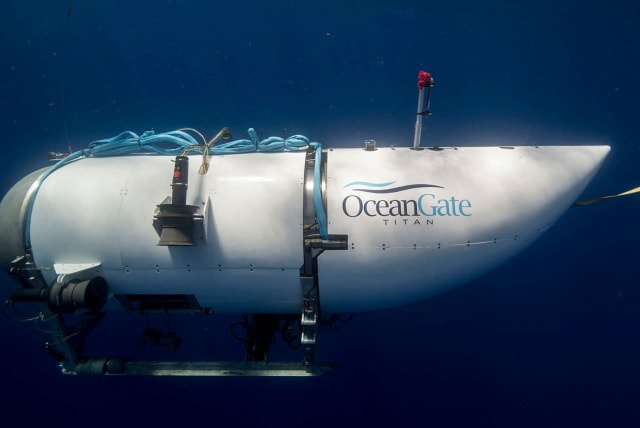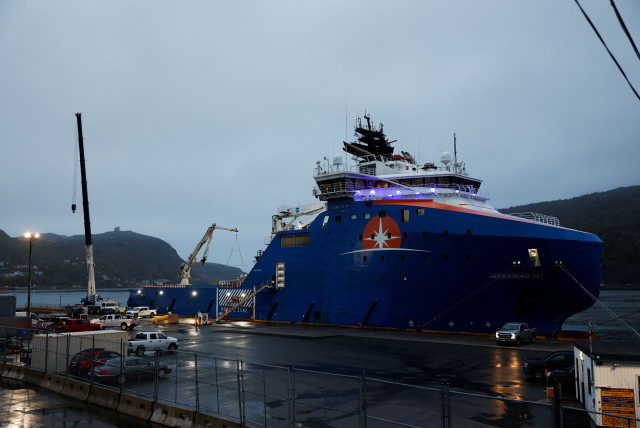Titanic submersible: Possible signs of life detected via sonar

Five passengers were on the missing submersible that can keep them alive underwater for a maximum of 96 hours.
Rescuers searching for a missing submersible near the wreck of the Titanic on Wednesday concentrated their efforts on a remote area of the North Atlantic where undersea noises have been detected, though officials cautioned the sounds may not have originated from the vessel.
With estimates suggesting the air supply on board could run out in a matter of hours, an international coalition of rescue teams was sweeping a vast expanse of the ocean for the Titan, which vanished on Sunday while carrying five people on a deep-sea voyage to the century-old shipwreck as part of a tourist expedition.
The US Coast Guard said remotely operated vehicles (ROV) were deployed underwater near where Canadian aircraft recorded the noises using sonar buoys on Tuesday and Wednesday but have not found any sign of the Titan yet.
Coast Guard Captain Jamie Frederick said at a press conference that analysis of the noises has been "inconclusive."
"When you're in the middle of a search-and-rescue case, you always have hope," he said. "With respect to the noises specifically, we don't know what they are, to be frank with you." Officials did not offer a detailed description of the sounds.
Even if the submersible is located, retrieving it presents huge logistical challenges, given the extreme conditions miles (thousands of meters) below the surface.
Teams from the United States, Canada and France using airplanes and ships have searched more than 10,000 square miles (25,900 square km) of open sea, roughly twice the land mass of the US state of Connecticut.
The 22-foot (6.7-meter) submersible Titan, operated by US-based OceanGate Expeditions, began its descent at 8 a.m. (1200 GMT) on Sunday. It lost contact with its surface support ship near the end of what should have been a two-hour dive to the Titanic.
Sean Leet, who heads a company that jointly owns the support ship, the Polar Prince, told reporters on Wednesday that "all protocols were followed" but declined to give a detailed account of how communication ceased.
"There's still life support available on the submersible, and we'll continue to hold out hope until the very end, Leet, CEO of Miawpukek Horizon Maritime Services, told reporters in St. John's Newfoundland.
The Titan set off with 96 hours of air, according to the company, which would mean the oxygen could run out by Thursday morning. But experts say the air supply depends on a range of factors, including whether the submersible still has power and how calm the people aboard have remained.
The wreck of the Titanic, a British ocean liner that struck an iceberg and sank on its maiden voyage in 1912, killing more than 1,500 people, lies on the seabed at a depth of about 12,500 feet (3,810 meters). It is about 900 miles (1,450 km) east of Cape Cod, Massachusetts, and 400 miles south of St. John's, Newfoundland.
Those aboard the submersible, the highlight of a tourist adventure that costs $250,000 per person, included British billionaire and adventurer Hamish Harding, 58, and Pakistani-born businessman Shahzada Dawood, 48, with his 19-year-old son Suleman, who are both British citizens.
French explorer Paul-Henri Nargeolet, 77, and Stockton Rush, founder and chief executive of OceanGate, were also reported to be on board.
A friend of Harding, Jannicke Mikkelsen, who has accompanied the British entrepreneur on other expeditions, told Reuters she was hoping for good news but was not optimistic. "It would be a miracle if they are recovered alive," she said.
Safety concerns have arisen
Questions about the Titan's safety were raised in a 2018 lawsuit filed by OceanGate's former director of marine operations, David Lochridge, who claimed he was fired for voicing concerns that the hull could not withstand extreme depths.
In its own court claim against Lochridge, OceanGate said he refused to accept the lead engineer's assurances and accused Lochridge of improperly sharing confidential information.
The two sides settled the case in November 2018. Neither the company nor Lochridge's attorney has commented on the details of the dispute.
Months prior to the lawsuit, a group of submersible industry leaders wrote to OceanGate warning that the "experimental" approach" to the sub's development could result in "minor to catastrophic" problems.
Aaron Newman, a former Titan passenger who knows some of the missing people, told NBC on Wednesday he felt safe during his dive.
"This is not a Disney ride," he said. "We're going places that very few people have been."
If the Titan managed to return to the surface, it could still be difficult to spot it in the open water, experts said. The submersible is sealed shut with bolts from the outside, making it impossible for those inside to escape without assistance.
If the Titan is on the ocean floor, a rescue effort would be even more challenging because of the massive pressures and total darkness at a depth of more than 2 miles. Titanic expert Tim Maltin said it would be "almost impossible to effect a sub-to-sub rescue" on the seabed.
A French research ship carrying a deep-sea diving robot submersible was expected to arrive later on Wednesday.
The remote-controlled vessel is capable of diving as deep as the Titanic wreck and could help free the submersible if it is stuck, though the robot cannot lift the 21,000-pound (9,525-kg) Titan on its own. The robot could also help hook the sub to a surface ship that is able to lift it, the operator said.
Jerusalem Post Store
`; document.getElementById("linkPremium").innerHTML = cont; var divWithLink = document.getElementById("premium-link"); if (divWithLink !== null && divWithLink !== 'undefined') { divWithLink.style.border = "solid 1px #cb0f3e"; divWithLink.style.textAlign = "center"; divWithLink.style.marginBottom = "15px"; divWithLink.style.marginTop = "15px"; divWithLink.style.width = "100%"; divWithLink.style.backgroundColor = "#122952"; divWithLink.style.color = "#ffffff"; divWithLink.style.lineHeight = "1.5"; } } (function (v, i) { });

